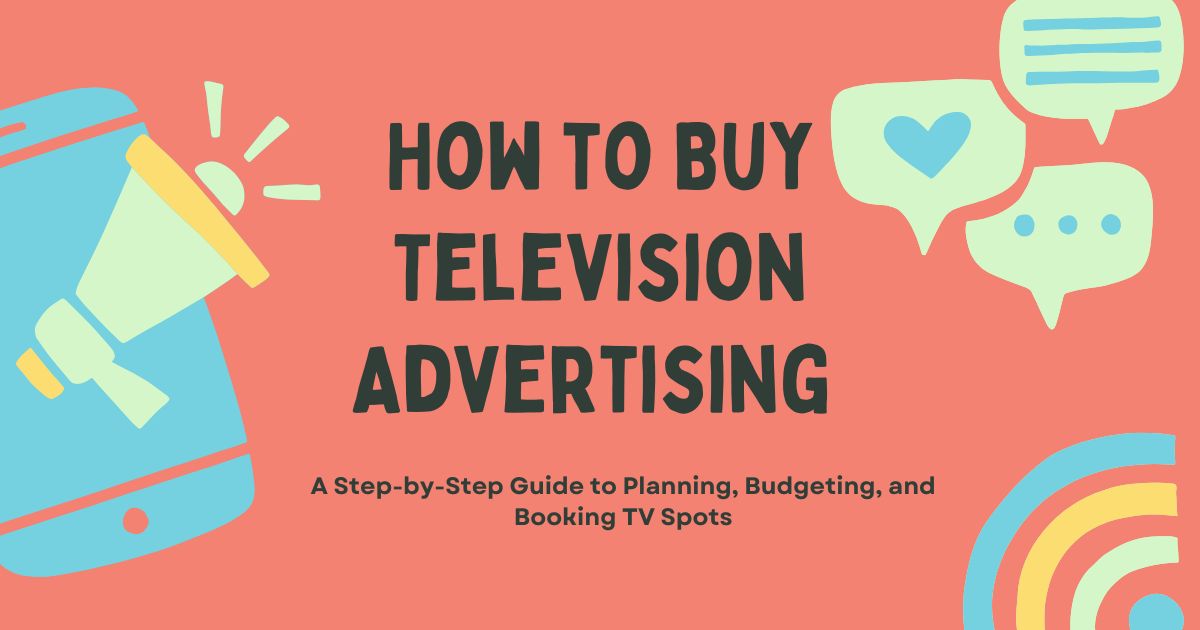Television advertising remains one of the most powerful ways to reach mass audiences and build brand awareness. While digital marketing dominates many conversations, TV advertising still delivers impressive results when executed correctly.
Whether you’re a small business owner considering your first TV campaign or a marketing professional looking to optimize your media buying strategy, understanding how to buy television advertising effectively can transform your marketing outcomes. This comprehensive guide will walk you through the entire process, from setting your budget to measuring campaign success.
Understanding the Television Advertising Landscape
Before diving into the buying process, it’s essential to understand the current TV advertising environment. The television landscape has evolved dramatically, offering advertisers more options than ever before.
Traditional vs. Connected TV
Traditional television includes broadcast networks (ABC, CBS, NBC, FOX) and cable channels (CNN, ESPN, Discovery). These platforms offer broad reach and established audience measurement systems.
Connected TV (CTV) and over-the-top (OTT) platforms like Hulu, Netflix, and Amazon Prime Video represent the newer frontier. These platforms offer precise targeting capabilities and detailed analytics that rival digital advertising.
Local vs. National Advertising
Local TV advertising targets specific geographic markets, making it ideal for businesses serving regional audiences. National advertising reaches viewers across the entire country but requires significantly larger budgets.
Setting Your Television Advertising Budget
Your budget determines every aspect of your TV advertising campaign. Most successful campaigns allocate 5-10% of their total revenue to advertising, though this varies by industry and business goals.

Factors Affecting TV Advertising Costs
Several elements influence television advertising costs:
Time of Day: Prime time (8-11 PM) commands the highest rates, while late-night and early morning slots cost significantly less.
Seasonality: Advertising rates peak during high-demand periods like holidays and major sporting events.
Market Size: Large markets like New York and Los Angeles cost more than smaller regional markets.
Program Popularity: Popular shows with large audiences charge premium rates.
Length of Commitment: Longer advertising commitments often secure better rates.
Choosing the Right Television Advertising Format
Television offers several advertising formats, each with unique advantages and costs.
Traditional Commercial Spots
Standard commercials range from 15 seconds to 2 minutes, with 30-second spots being most common. These ads play during scheduled commercial breaks and reach the program’s entire audience.
Sponsorships and Integrations
Sponsorship opportunities include title sponsorships, segment sponsorships, and product integrations. These formats often provide better brand recall than traditional commercials.
Infomercials
Long-form commercials lasting 30 minutes or more work well for complex products requiring detailed explanations. They’re typically more affordable than traditional spots.
Targeting Your Television Audience
Effective targeting ensures your message reaches the right viewers at the right time.
Demographics and Psychographics
Television networks provide detailed audience demographics including age, gender, income, and lifestyle preferences. Use this data to select programs that attract your target customers.
Geographic Targeting
Local advertising allows precise geographic targeting, from entire metropolitan areas to specific zip codes. This precision helps local businesses maximize their advertising investment.
Behavioral Targeting
Modern TV advertising platforms offer behavioral targeting based on viewing habits, purchase history, and online activity. This capability bridges the gap between traditional and digital advertising.
Working with Television Advertising Partners
Successful TV advertising campaigns require the right partnerships and expertise.
Advertising Agencies
Full-service advertising agencies handle everything from creative development to media buying. They bring expertise and industry relationships that can secure better rates and placements.
Media Buying Agencies
Specialized media buying agencies focus specifically on purchasing advertising time. They often have strong relationships with networks and can negotiate favorable terms.
Direct Network Relationships
Some businesses work directly with television networks, particularly for local advertising. This approach requires more internal expertise but can reduce costs.
Creating Compelling Television Advertisements
Your advertisement’s creative quality significantly impacts campaign success.
Professional Production
Television audiences expect high production values. Invest in professional videography, audio, and editing to ensure your ad meets broadcast standards.
Clear Messaging
Television viewers have limited attention spans. Focus on one primary message and include a clear call-to-action.
Brand Consistency
Ensure your TV advertising aligns with your overall brand identity and marketing messages across all channels.
Measuring Television Advertising Success
Tracking your campaign’s performance helps optimize future advertising investments.
Traditional Metrics
Gross Rating Points (GRPs): Measure the total exposure of your advertisement across the target audience.
Reach and Frequency: Track how many people see your ad and how often they see it.
Cost Per Rating Point (CPP): Calculate the cost efficiency of your media buy.
Modern Analytics
Website Traffic: Monitor traffic spikes during and after your TV spots air.
Phone Calls: Track call volume increases that correlate with your advertising schedule.
Social Media Engagement: Measure social media activity related to your TV campaign.
Sales Attribution: Use promo codes or special offers to directly track sales generated by TV advertising.
Negotiating Television Advertising Rates
Rate negotiation can significantly impact your campaign’s cost-effectiveness.
Timing Your Buy
Purchasing advertising time well in advance often secures better rates. Networks offer discounts for early commitments and guaranteed spending levels.
Package Deals
Bundle multiple spots or combine different time slots to negotiate better overall rates.
Flexibility Benefits
Accepting flexible scheduling allows networks to place your ads when inventory is available, often at reduced rates.
Optimizing Your Television Advertising Campaign
Continuous optimization ensures maximum return on your advertising investment.
Performance Monitoring
Track key performance indicators daily during your campaign. Quick adjustments can improve results and prevent wasted spending.
Creative Testing
Test different creative versions to identify the most effective messaging and format for your audience.
Schedule Optimization
Analyze which time slots and programs generate the best results, then reallocate budget accordingly.
Common Television Advertising Mistakes to Avoid

Learning from common pitfalls can save time and money.
Insufficient Budget Planning
Underestimating total campaign costs, including production expenses, leads to incomplete campaigns that fail to achieve objectives.
Poor Timing
Launching campaigns during inappropriate seasons or times can waste advertising dollars and miss target audiences.
Inadequate Tracking
Failing to implement proper tracking systems makes it impossible to measure success or optimize future campaigns.
Neglecting Production Quality
Low-quality advertisements reflect poorly on your brand and may not meet broadcast standards.
Maximizing Your Television Advertising Investment
Television advertising success comes from strategic planning, careful execution, and continuous optimization. Start with clear objectives and realistic budgets. Choose the right partners and invest in quality creative development.
Remember that television advertising works best as part of an integrated marketing strategy. Combine your TV campaigns with digital marketing, social media, and other channels for maximum impact.
Understanding how to buy television advertising that actually works can enhance brand reach, especially when paired with insights into how luxury brands market themselves and leave a lasting impression.





